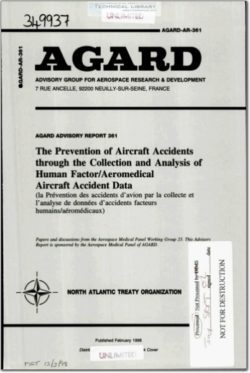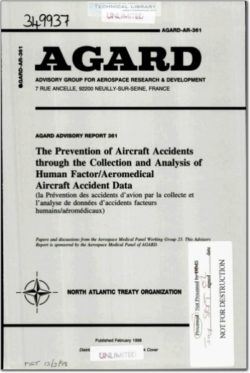AGARD-AR-361

- Version
- 113 Downloads
- 13.17 MB File Size
- 1 File Count
- April 25, 2016 Create Date
- April 25, 2016 Last Updated
The Prevention of Aircraft Accidents through the Collection and Analysis of Human Factor/Aeromedical Aircraft Accident Data

Human factors are involved in the majority of the aircraft accidents and incidents as a primary causal element. In
September 1992, representatives of all countries in AGARD Conference 532, Aircraft Accidents: Trends in
Aerospace Medical Investigation Techniques, agreed with Dr. Levy’s conclusions and recommendations in order
to improve the man-machine interface and reduce error accidents.
Main emphasis was made to determine why the accident occurred and how to properly conduct an investigation,
considering, as a whole, aircraft, design, operational procedures, aircrew, ground crew, training, physiological
psychosocial and psychological factors influencing personnel involved in the chain of events leading to the
accident. '
Aircraft accidents can-be seen as the most extreme form of failure in flight safety work, the human factors
involved should be carefully analyzed in order to add them to a common bank of experience in the NATO
community. There is a need for establishing a discrete record, as complete as possible, standardized and including
information of all personnel causally involved in the accident. As a result, better compatibility and comparability
between different databases will be possible.
Working Group 23 believes that a united collection of human factors data could be used to analyze human error
and perform meta-analysis of all occurrence reports. Such a database would contain uniform human factor
information for comparison and statistical analysis. This system is essential to validate or refute association
between related factors and detect trends or tendencies.
Research results could be made available quickly to aid current investigations and assist development of new
aircraft systems.
The result would be a greater understanding of the role of human factors in accident causation, better education in
human factors in general and improved investigation training.
In 1993, a proposal for a working group was made by the Biodinamic subcommittee of AGARD-AMP under the
original title of “Database Collection in Aircraft Accident Investigation,” but final approval of the so—called
W623 did not happen until 1994. The scope of W623 was the development of an Aircraft Accident Human
Factors data base analysis capability that would provide valid statistical association and development of a NATO
training program for accident investigators, both with an operational application of HF analysis to a program of
prevention.
| File | Action |
|---|---|
| AGARD-AR-361 The Prevention of Aircraft Accidents through the Collection and Analysis of Human Factor_Aeromedical Aircraft Accident Data.pdf | Download |

Comment On This Post